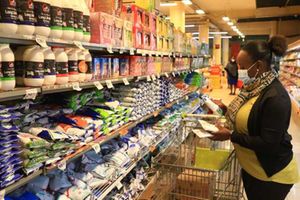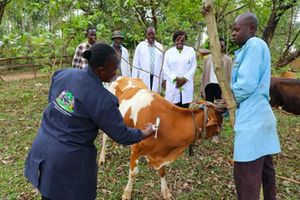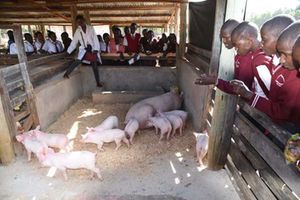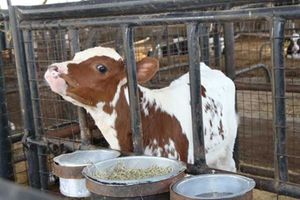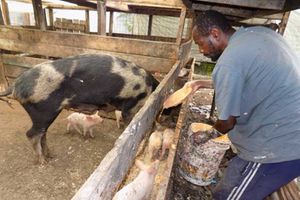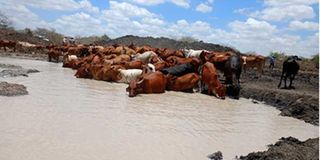
Cattle at a water pan under construction in the 34,000-acre Kambanga Ranch, Taita Taveta County. It is one of the few counties with large cattle ranches.
Ranching used to be the best way of producing beef when the world population was still low and there were large tracts of land. In Kenya, the older generation is aware of the large ranches that existed mainly in the arid and semi-arid lands or Asals.
I recall the ranches in Nairobi, Machakos, Kiambu, Murang’a and Nyeri among other counties. Today, ranches are found mainly in Kajiado, Narok, Laikipia, Taita Taveta and the Coast.
Most of the land that used to be beef ranches has been divided into small pieces for settlement and can no longer support such ventures.
Most of the beef in Kenya is produced through family pasture grazing in communal aggregated herds in the Asals, away from major urban centres. Unfortunately, pasture grazing is an inefficient way of producing beef in terms of quality and quantity.
The animals take long to mature and the meat is of poor quality. It is hard with a lot or little fat, depending on the season the animals are slaughtered and their age.
Most of the animals under open pasture grazing attain slaughter weight at 36-60 months or more. Open grazing is also unsuitable for improved beef cattle and the European breeds or Bos taurus.
Therefore, the meat is produced from indigenous cattle mainly the Boran, Sahiwal and the small East African Zebu.
These breeds have less and tougher meat compared with Bos taurus.
The slow rate of growth of the local beef breeds under open grazing and the reduction of land available for ranching has resulted in shortage of beef in the country.
The annual beef shortfall is estimated to be about 250,000 metric tonnes. This figure can only keep rising because of the yearly increase in the human population and the continuous reduction in farming land as more people settle on previously livestock production farms.
Kenya attempts to fill the meat deficit by importing beef and live slaughter animals from Brazil and other countries.
Kenya should be able to satisfy its beef needs if better, modern production methods are adopted.
Beef feedlot farming is a method used worldwide to produce high quality meat under controlled conditions.
I have seen Kenyans venture into beef feedlot farming in recent years. However, many have not sustained their ventures due to inadequate knowledge to understand that the farming is a science and a business.
The science component is that the farmer must understand the development of the cattle body and feed requirements.
One must also know that they would only make their money within a specified window of 90 to 120 days.
During this time, the animals are put into the feedlot and given a highly nutritious diet that enables them to gain 0.7 to 1.5 kilogrammes of body weight per day.
The extra weight gained is the new money the farmer makes with the animals. That money must be sufficient to meet the costs of the operation and make the farmer an acceptable profit.
Therefore, a beef feedlot farmer must ensure her operation is scientific and precise with management.
Two months ago, one of my clients started establishing a beef feedlot in Athi River.
We had started the planning in 2024 and eventually settled on building in March 2025. Beef feedlots should be established preferably in dry areas to reduce the cost of operation.
Though dry areas have the challenge of water supply, there are few illnesses and little energy is spent by the animal to maintain normal body temperature.
This helps to save on the cost of feeds and veterinary services. Dry regions also help to save on the initial cost of construction because the rearing pens and internal access roads need not be paved.
In this article, I will share our progress in building the feedlot to give insight to other Kenyans who would wish to invest in reducing the annual beef deficit in the country, create employment, earn some money and contribute to ensuring national food security.
We started by developing the concept for the beef feedlot in 2024.
Read: Farm where beef is made
I discussed with the investor and we agreed on the number of animals that were viable for his objective. It worked out to production of about 400 head of cattle per year in lots of 100.
That means he would stock about 110 animals per lot to ensure that at least 100 would achieve the targeted weight of 500 kilos during their stay in the feedlot.
The investor agreed the annual production of 400 animals may not achieve his targeted scale of business. However, it was important to start at a manageable level for him and his team to gain adequate knowledge on beef feedlot farming before scaling up gradually to about 1,000 animals per year.
Other conceptual considerations were the breed and sex of animals that would be recruited into the feedlot and how marketing for the finished animals would be. I advised we settle on bulls of Sahiwal, Boran or their mixtures but avoid the East African zebu. This breed is unsuitable for feedlot because of its low mature weight and weight gain.
With the investor, we identified the potential market for his finished cattle. We were happy to confirm with the potential market actors that they in fact have a deficit in the supply of quality beef cattle for slaughter.
I did the project drawings in February 2025. Together with the investor, we recruited an experienced consultant for beef feedlot operation to supervise the construction, survey suppliers for equipment, feed inputs and the starting stock.
Establishing a feedlot requires experts with the various skills and experiences. The project team, therefore, comprised the investor and two experts.
In early March, we recruited the contractor and cost the project fully.
Initially, the construction was going to be mainly with metal but the cost went too high. We reverted to wood, combined with little metal.
Construction started in the middle of March and is now almost complete. The starting cattle stock of 110 steers of about 300kg live weight have been booked with a rancher.
We expect to stock the feedlot with the cattle by the end of May. I invite readers to walk the journey of this new feedlot with us.

